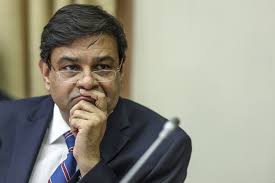India’s growth will bounce back after a sharp slowdown:Urjit Patel.
 MUMBAI : India’s growth will bounce back after a sharp slowdown triggered by Prime Minister Narendra Modi’s clampdown on cash, said central bank Governor Urjit Patel.
MUMBAI : India’s growth will bounce back after a sharp slowdown triggered by Prime Minister Narendra Modi’s clampdown on cash, said central bank Governor Urjit Patel.
“Almost everyone agrees that the impact is going to be a sharp ‘V,’ that we would have a downgrade of growth for a short period of time,” Patel told CNBC-TV18 in an interview telecast Friday. “However the remonetization has happened at a fast pace and that was part of the plan.”
The benefits of the unprecedented Nov. 8 decision to cancel 86 percent of currency in circulation will take time to fully play out and need more work to ensure they’re lasting, he said. His statement follows record outflows from Indian stocks last quarter as investors fretted about the impact of the demonetization as well as a U.S. interest-rate increase that economists say has ended India’s easing cycle.
Patel kept the benchmark repurchase rate unchanged at 6.25 percent for a second straight meeting this month and changed the policy stance to “neutral” from “accommodative,” the first change since 2015. While consumer-price gains slowed, core inflation — which strips out volatile food and fuel costs — has been sticky and imperils the 4 percent mid-point of India’s inflation target range, Patel said.
“So, given how the inflation outlook changes, if at all, over the next few readings in terms of the data that comes about and our projections based on that for the next fiscal year,” a neutral stance gives the Reserve Bank of India more flexibility to cut, raise or hold rates as compared with an accommodative stance, he said.
US Trade Policy
“The comments do suggest that the rate easing cycle is over,” said Shilan Shah, Singapore-based India Economist at Capital Economics. “Demand is picking up as is spending which means we will see a strong recovery in growth.”
Patel also expressed concern about a potential shift to trade protectionism under U.S. President Donald Trump but said financial markets have priced in most of the expected interest-rate increases from the Federal Reserve.
India’s sound macroeconomic fundamentals — smaller budget deficit, flexible inflation targeting, high foreign-currency reserves and a modest current-account deficit — put the country in a good place to weather volatility, he said.
“We are at an important juncture and the possibility of negative consequences for countries around the world is a possibility,” Patel said. “Asia may come in for special treatment because almost two-thirds of the U.S. trade deficit in goods is with respect to Asia. We just have to see how things evolve in terms of tangible policy changes which the U.S. government so far seems to be fairly determined to carry through.”
India must stick with its open trade regime, he said. Patel also said that the rupee is “broadly where it should be.” The currency has gained 1.2 percent in 2017 to 67.11 a dollar as of 9:28 a.m. in Mumbai, after falling to a record last year.
Concerns for India stem from a hardening of global commodity prices and “lack of a consistent policy enunciation from major economies is the main source of volatility,” Patel said. The RBI predicts gross value added — a key input of gross domestic product — to grow 7.4 percent in the fiscal year starting April 1 from 6.9 percent the previous year.
“The best way that a central bank can support growth on a durable basis is to ensure that the inflation is low, stable, there is financial stability and that is the role that the central bank plays,” Patel said.
© 2017 Bloomberg L.P

